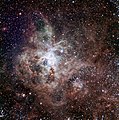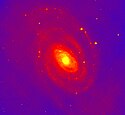První světlo
Jako první světlo se označuje okamžik, kdy je dalekohled poprvé použit k získání astronomických záběrů (či přeneseně jiný přístroj poprvé využit pro svůj hlavní účel). Nejedná se o první použití daného dalekohledu, neboť před pořízením prvních snímků je obvykle potřeba provést řadu optických testů a kalibrací. Častým cílem prvního světla je nějaký známější a efektní objekt.
První získaný snímek má jen zřídka nějakou vědeckou hodnotu, neboť kvalita obrazu ještě nedosahuje plně možností daného přístroje. Přesto je to velmi očekávaný okamžik pro jeho obsluhu a astronomickou obec vůbec, neboť dalekohled poprvé dodá nějaké výstupy.
Galerie
Snímek spirální galaxie NGC 5364 z prvního světla dalekohledu VIMOS, jedné ze součástí Very Large Telescope
První snímek z Hubblova vesmírného dalekohledu pořízený pomocí fotoaparátu WFPC
- (c) TRAPPIST/E. Jehin/ESO, CC BY 4.0
Fotografie Mlhoviny Tarantule z prvního světla dalekohledu TRAPPIST
Reference
V tomto článku byl použit překlad textu z článku First light (astronomy) na anglické Wikipedii.
Média použitá na této stránce
(c) TRAPPIST/E. Jehin/ESO, CC BY 4.0
This first light image of the TRAPPIST national telescope at La Silla shows the Tarantula Nebula, located in the Large Magellanic Cloud (LMC) — one of the galaxies closest to us. Also known as 30 Doradus or NGC 2070, the nebula owes its name to the arrangement of bright patches that somewhat resembles the legs of a tarantula. Taking the name of one of the biggest spiders on Earth is very fitting in view of the gigantic proportions of this celestial nebula — it measures nearly 1000 light-years across! Its proximity, the favourable inclination of the LMC, and the absence of intervening dust make this nebula one of the best laboratories to help understand the formation of massive stars better. The image was made from data obtained through three filters (B, V and R) and the field of view is about 20 arcminutes across.
This image from NASA's Kepler mission shows the telescope's full field of view -- an expansive star-rich patch of sky in the constellations Cygnus and Lyra stretching across 100 square degrees, or the equivalent of two side-by-side dips of the Big Dipper. A cluster of stars, called NGC 6791, and a star with a known planet, called TrES-2, are outlined. The cluster is eight billion years old, and located 13,000 light-years from Earth. It is called an open cluster because its stars are loosely bound and have started to spread out. TrES-2 is a hot Jupiter-like planet known to cross in front of, or transit, its star every 2.5 days. Kepler will hunt for transiting planets that are as small as Earth.
Autor: ESO, Licence: CC BY 4.0
The spiral galaxy NGC 5364 was the first object to be observed with the VIMOS instrument. This false-colour near-infrared raw First Light image reveal extensive structure in the spiral arms of the galaxy.
The image consists of a 60 sec exposure of NGC 5364 on February 26, 2002; image quality 0.6 arcsec FWHM; full moon; field of view 3.5 x 3.5 arcmin2 ; North is up and East is left.
ID: 09e-02
Press Release: 04/02
Object: NGC 5364
Telescope: UT3/Melipal
Instrument: VIMOS
Size: 800x737
Credit: ESO
Cross Identifications: NGC 5317, NGC 5364, UGC 8853, MCG +1-36-3, PGC 49555, CGCG 46-9, IRAS 13536+0515 (Revised NGC Data for NGC 5317)This image is part of the first image taken with NASA's Hubble Space Telescope's (HST) Wide Field/Planetary Camera. All objects seen are stars within open cluster NGC 3532 in the Milky Way galaxy. Stars pictured in the HST frame are sharper than ground telescope images and well resolved, as shown by the double star at the top of the image. By avoiding the Earth's atmosphere, the HST gives sharper images and better resolution. In this early engineering picture, the HST images are roughly 50 percent sharper than the ground-based images.
Technical Details: The first image taken with the HST is intended to assist in focusing the telescope. The region observed is centered on the 8.2 magnitude star HD96755 in the open cluster NGC 3532, in the southern constellation Carina. Identical small subsections of the HST and ground-based image pictures were chosen to highlight the difference in resolution. The field shown is approximately 11 x 14 arcseconds in size and does not contain HD96755.
The HST image is a thirty-second exposure taken by the Wide Field/Planetary Camera. The picture shown was extracted from the area observed by the WF-3 OCD using the F555W broadband filter. The measured width of star profiles (FWFM) gives a good indication of the angular resolution. The FWFM of the stars in the HST picture is about 0.8 arcseconds, compared to 1.1 arcseconds for normal ground telescopes, which points out the remarkable increase in resolution of the HST even at this early stage of the focusing task.






